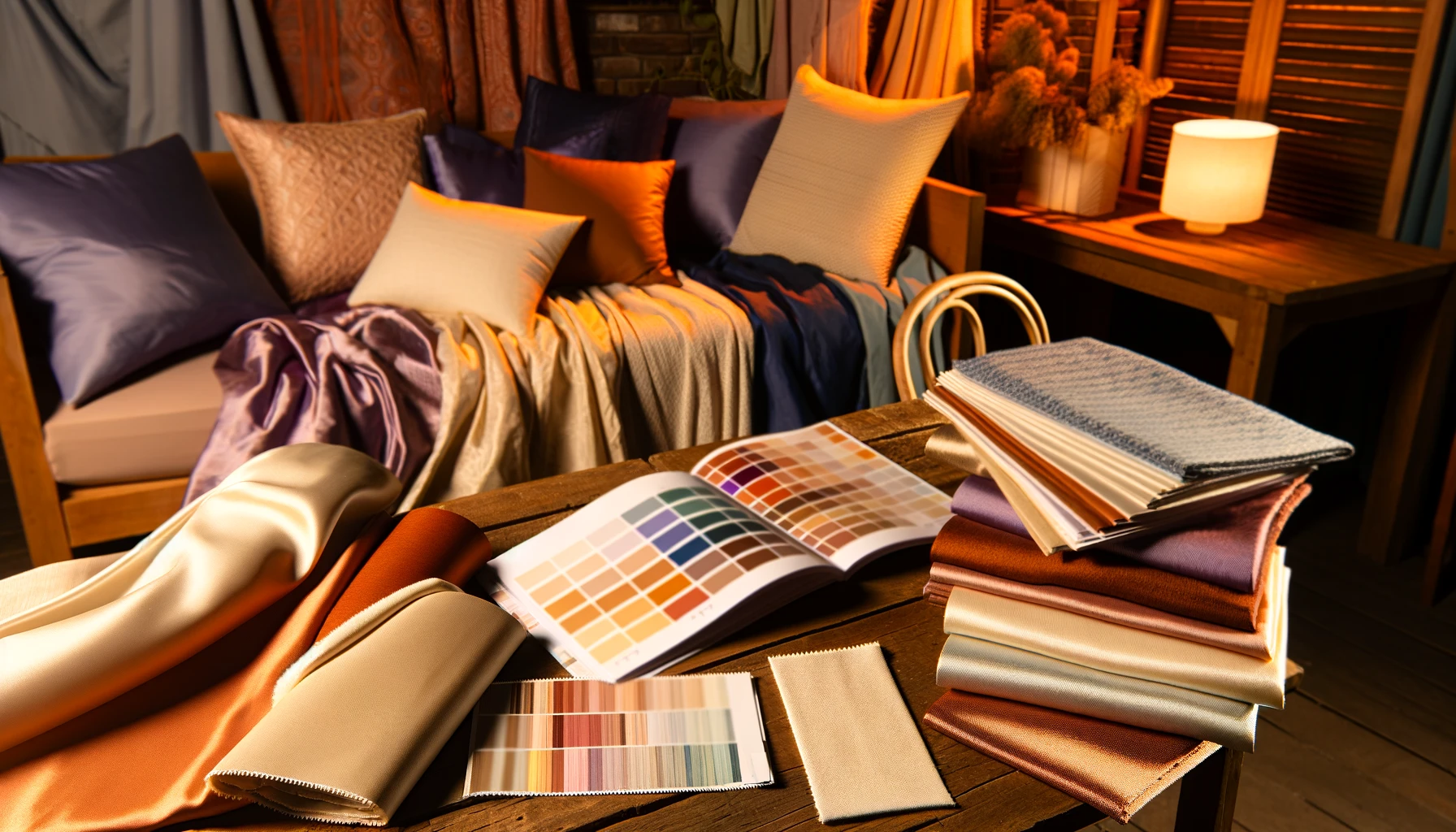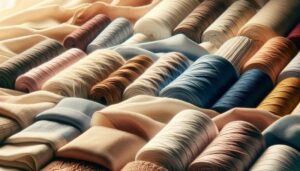Fabrics for Bedding: Choosing the Perfect Material for a Dreamy Sleep
Sleep is not only a time of recovery for our body and brain but also a comfy space where we can shake off the day’s stresses and unwind from our everyday routine. And one of the key aspects to creating a cozy atmosphere in the bedroom is choosing the perfect bedding. It is what turns an ordinary night’s sleep into a tranquil, dream-filled haven.
Today, I want to share with you my experience in choosing fabric for bedding sheets. It might seem a simple task, but there’s more to it than meets the eye.
Selecting the right fabric for bedding is crucial for a good night’s sleep. Different fabrics offer varying levels of softness, breathability, and durability, which directly influence comfort and overall sleep quality. For instance, cotton is renowned for its softness and breathability, making it ideal for those who tend to overheat during the night. On the other hand, silk offers a luxurious feel and is gentle on the skin, perfect for those seeking a touch of indulgence. Additionally, factors such as hypoallergenic properties and ease of maintenance should also be considered when choosing bedding fabrics to ensure optimal comfort and sleep hygiene.
The world of bedding fabrics is a treasure trove of possibilities, each offering its own unique blend of comfort and luxury. So, let’s dive into the pleasant world of fabrics for bedding and find the perfect cloth that will transform your bedroom into a realm of tranquil sleep.
Table of Contents
Cotton Sheets Bedding
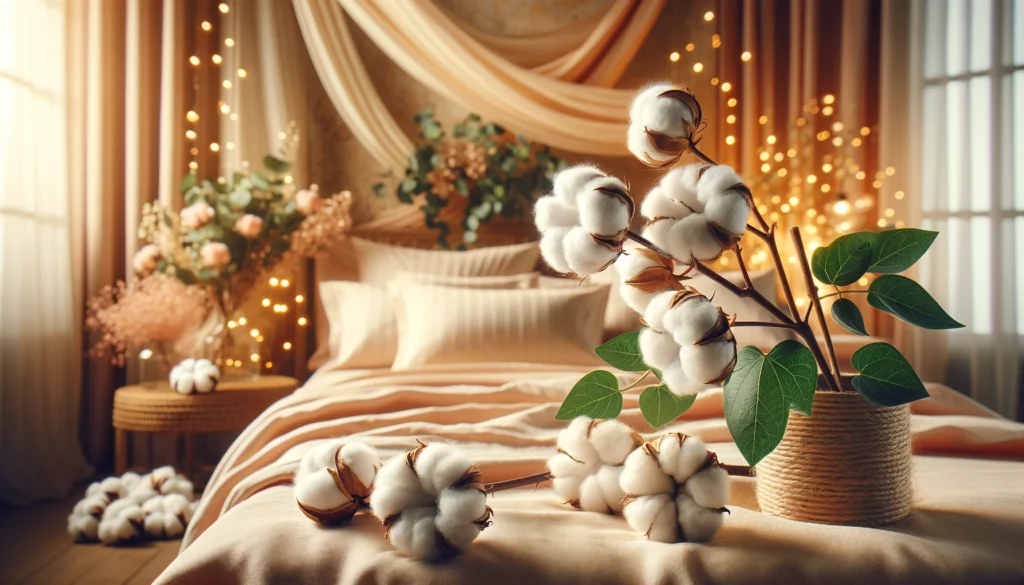
Cotton Sheets Bedding: Embrace the Timeless Comfort
Cotton has long been hailed as the reigning champion of bedding fabrics, and it’s not hard to see why. With its unbeatable breathability, cloud-like softness, and remarkable durability, cotton sheets bedding has won the hearts of sleep enthusiasts far and wide.
The popularity of cotton bedding can be attributed to several factors. Firstly, cotton is celebrated for its exceptional breathability, allowing for optimal airflow and temperature regulation throughout the night. This breathability helps prevent overheating, ensuring a comfortable sleep experience, especially during warmer months.
Moreover, cotton is prized for its luxurious softness, providing a gentle touch against the skin for a truly indulgent sleep. This softness only improves with each wash, making cotton sheets and bedding a long-lasting investment in comfort.
Additionally, cotton is renowned for its durability, with high-quality cotton sheets retaining their shape and texture even after numerous washes. Your cotton bedding remains resilient against everyday wear and tear, offering lasting comfort for many years.
When exploring different types of cotton, Egyptian cotton stands out for its exceptional quality and luxurious feel. Known for its long fibers, Egyptian cotton produces exceptionally soft and lined yarns, resulting in sumptuously smooth and durable bedding.
Similarly, Pima cotton, also known as Supima cotton, is celebrated for its superior quality and softness. Grown primarily in the southwestern United States, Pima cotton boasts long, fine fibers that contribute to its exceptional softness and durability.
For those prioritizing sustainability, organic cotton sheets bedding offers a conscientious choice. Grown without the use of synthetic pesticides or fertilizers, organic cotton is not only gentle on the skin but also on the planet, making it an eco-friendly option for environmentally conscious consumers.
Despite all the advantages of cotton bed linen, it is still important to note a couple of its drawbacks. Firstly, cotton fabric wrinkles easily, so you will have to iron it or fold it very carefully if you want to sleep on perfectly flat sheets. Additionally, cotton can shrink when exposed to high temperatures, so strictly follow the care instructions for your cotton bedding to minimize this risk and enjoy it for a long time.
In summary, whether you’re drawn to the luxurious feel of Egyptian cotton, the superior softness of Pima cotton, or the eco-friendly appeal of organic cotton, cotton sheets bedding offers unparalleled convenience, breathability, and durability for a blissful night’s rest.
Linen Sheets Bedding
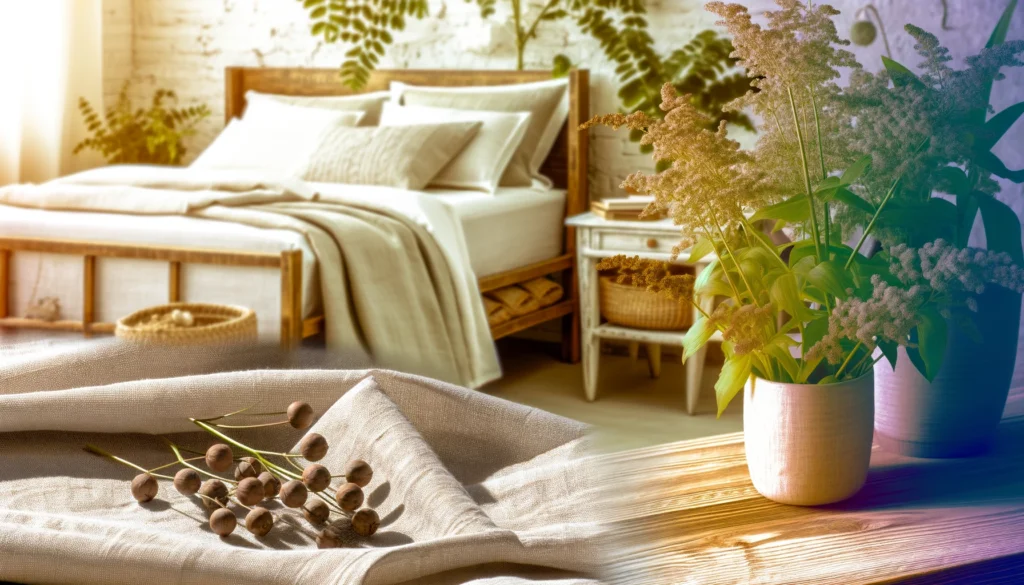
Linen Sheets Bedding: Effortlessly Elegant and Durable
When it comes to bedding that exudes luxury and stands the test of time, linen sheets bedding undeniably reigns supreme. Linen bedding offers an exceptional mix of sophistication and durability, making it a favorite among discerning sleepers.
The natural texture of linen is a key feature, providing a sensory experience unmatched by other fabrics. Linen bedding sets, slightly rough but irresistibly pleasant to the touch, will enrich the aesthetic appeal and add rustic charm to any bedroom.
One of the most valuable qualities of linen sheets bedding is its exceptional breathability. Unlike synthetic fabrics, which trap heat and moisture, linen allows air to circulate freely, keeping you cool and comfortable all night. This breathability makes linen bedding particularly well suited for hot weather sleepers or warm climates, providing a restful and restorative sleep.
Another outstanding feature of linen bedding is its excellent ability to regulate temperature. It keeps you cozy in winter and cool in summer thanks to its insulating properties and ability to wick moisture.
In addition to its practical benefits, linen adds sophistication to any interior. Whether you prefer a classic white linen bedding set or a modern patterned one, linen will give your sleep space a timeless and refined aesthetic.
But perhaps the most attractive aspect of linen bedding is the fact that it becomes softer and more flexible with every wash, resulting in a sleeping surface that only gets better with time. The tactile pleasure of sinking into freshly laundered linen sheets is equivalent to taking two sleeping pills (at least) 🙂.
One of the few disadvantages of linen sheets bedding is its ability to wrinkle easily, which requires a special washing regime and, possibly, more frequent ironing.
To sum it all up, the elegant appearance and unique feel of linen bedding is an unmistakable choice for those seeking supreme comfort and style.
Silk Bedding

Silk Bedding: Luxurious Comfort Fit for Royalty
Silk bedding sets a benchmark of luxury that few other fabrics can match. Renowned for its sumptuously smooth texture, silk bedding offers a sleep experience that is as magnificent as it is comfortable.
One of silk’s most renowned qualities is its unsurpassed smoothness. The gentle glide of silk over the skin causes our skin sensors to send powerful pleasure signals to the brain. This pleasant sensation enhances comfort and contributes to a relaxing sleep.
The incredible smoothness of silk also has a beneficial effect on our hair, especially curly hair―silk pillowcases do not fluff up the hair and do not break the curls during sleep!
One more benefit of silk bedding is its hypoallergic effect, making it ideal for everyone with sensitive skin or allergies. Silk bedding is naturally resistant to mold, dust mites, and mildew, creating a cleaner and healthier sleep environment.
Silk bedding regulates body temperature better than that made of cotton or linen, reliably safeguarding your comfort while sleeping. Also, natural silk does not electrify, unlike some synthetic fabrics.
Some may find silk too delicate, some may consider it too expensive, and others may find it too tedious to take special care of. But I bet that just one night on silk bedding will make you its fan for life.
Wool Bedding
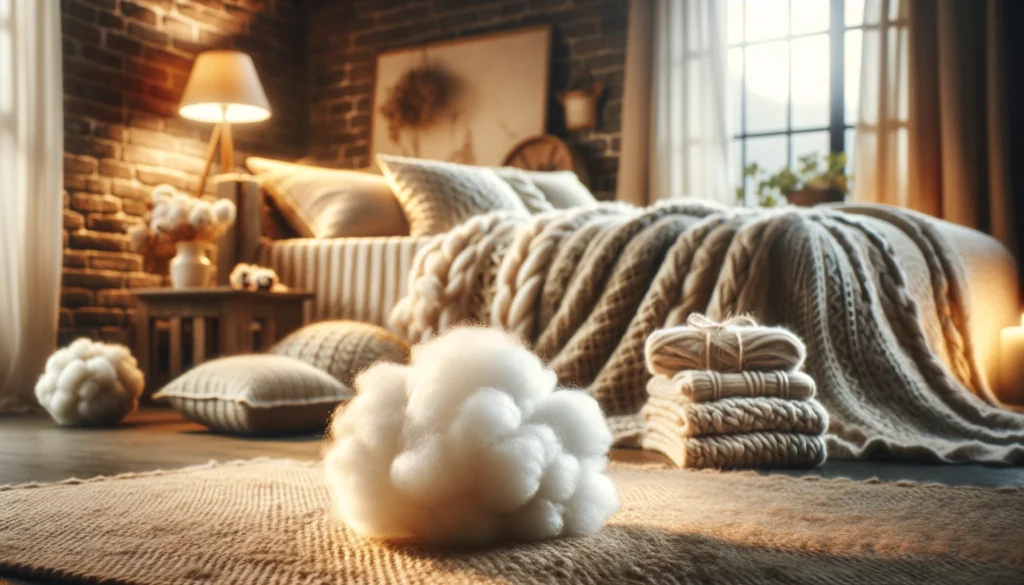
Wool Bedding: Nature’s Insulator for Year-Round Comfort
Wool bedding is a unique option for those who value a comfortable and natural sleep. Bedding wool has several excellent properties, making it an ideal choice for year-round use.
One of the most valuable characteristics of wool is its natural insulating effect. It retains warmth in the winter and maintains coolness in the summer, allowing the skin to breathe and avoid overheating. In other words, wool bedding adapts to your needs in different seasons, providing optimal comfort.
In addition, wool has an excellent ability to absorb moisture. It can effectively wick excess moisture away from your body, helping to keep you dry and fresh while you sleep. This ability also makes wool bedding an excellent choice for people with allergies, as it reduces the likelihood of developing allergic reactions.
Wool bedding has one feature that can scare away unprepared sleepers―it “bites.” However, this property is very beneficial for the skin. The effect of wool fabric on the skin is equivalent to a stimulating and rejuvenating micro-massage!
Wool’s indigenous insulating effect, moisture-wicking properties, and hypoallergenic qualities make wool bedding an ideal choice for those looking for a natural and effective solution to improve the quality of their sleep.
Bamboo Bedding

Bamboo Bedding: Sustainable Softness and Breathability
Bamboo bedding offers multiple benefits that elevate the sleep experience to new heights.
One of the standout features of bedding bamboo is its luxurious softness. The fibers derived from bamboo are inherently smooth and gentle against the skin, providing a sensation of plush comfort. Whether you prefer silky-smooth bamboo sheets or cozy bamboo blankets, this fabric envelops you in a cocoon of comfort every time you crawl into bed.
In addition to its softness, bamboo bedding is known for its outstanding breathability. The natural microstructure of bamboo fibers allows air to circulate freely, helping to regulate body temperature and keep you comfortable throughout the night.
Furthermore, bamboo fibers have a high absorbency rate, drawing moisture away from the skin and allowing it to evaporate quickly, leaving you feeling cool, dry, and comfortable all night. This makes bamboo bedding an excellent choice for those who perspire during sleep or live in humid environments.
And one of the paramount qualities of bamboo bedding is its environmental friendliness. Bamboo is a fast-growing and renewable resource that requires minimal water, pesticides, and fertilizers, making it a highly eco-friendly alternative to traditional materials. In addition, bamboo has natural antibacterial and antimicrobial properties, which reduces the need for chemical treatments and further enhances the sustainability of bamboo bedding.
The disadvantages of bamboo bedding include its relatively high cost and slightly shorter durability compared to linen or cotton bedding.
In summary, when choosing bamboo bedding for your bedroom, you will get a winning combination of softness, breathability, moisture-wicking properties, sustainability, and eco-friendliness.
Microfiber Bedding Set

Microfiber Bedding Set: The Practical Choice for Everyday Comfort
The popularity of microfiber bedding sets has increased significantly due to their practical qualities that combine comfort, durability, and convenience. Microfiber bedding is as soft, durable, and wrinkle-resistant as other high-quality fabrics but at a much more affordable price.
Softness is a standout feature of microfiber bedding sets. The fine threads in microfiber construction create a plush surface that caresses the skin, promoting relaxation and enriching sleep quality.
Durability is another hallmark of microfiber bedding engineered to withstand regular use and frequent washing. Unlike natural fibers such as cotton, microfiber is inherently resistant to pilling and fraying, ensuring that the bedding maintains its integrity over time, even with repeated laundering.
Wrinkle resistance adds to the appeal of microfiber bedding sets, as they emerge from the dryer virtually crease-free, preserving a neat and pristine appearance without ironing. This feature not only saves time and effort but also ensures that the bedding looks fresh and inviting on the bed, enhancing the overall aesthetic of the bedroom.
Microfiber bedding sets are incredibly low-maintenance, requiring minimal effort to keep them looking their best. They can be easily machine washed and dried, withstanding frequent laundering without losing their softness or color vibrancy.
As for disadvantages, microfiber can be electrified (this problem is easily solved by antistatic treatment). Microfiber bed linen should not be dried on radiators or in the open sun, as this destroys the microfibers and makes the fabric rougher. Also, if washed rarely, microfiber bedding can accumulate subcutaneous fat, which is hard to wash away, so it is advisable to do laundry once every 7-10 days.
In summary, affordable and easy to care for, microfiber bedding offers a sound sleeping experience without the hefty price tag or high care requirements, making it a universal and practical option for any bedroom.
Tencel Bedding
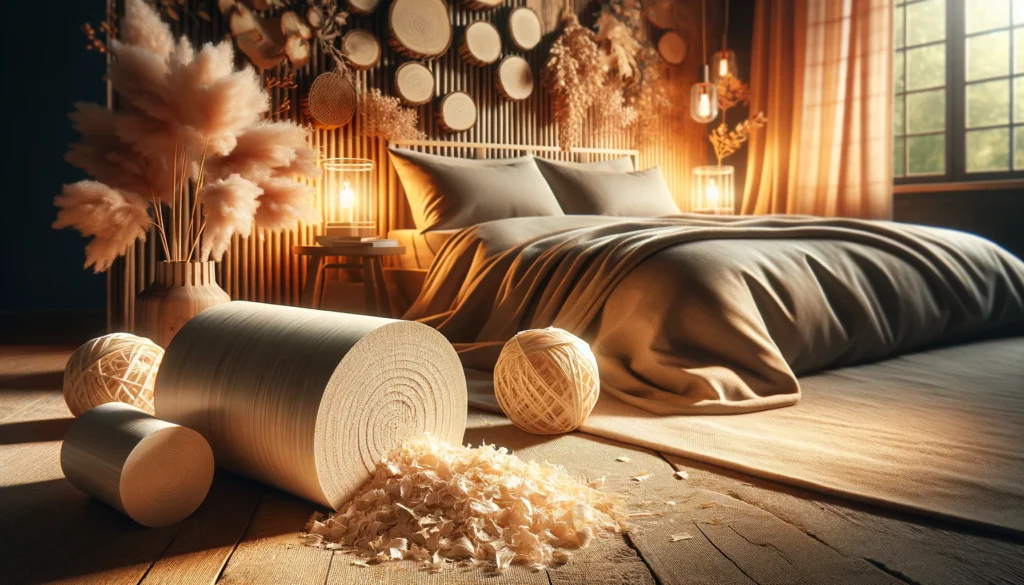
Tencel Bedding: Sustainable Luxury Derived from Nature
Tencel bedding sets are becoming increasingly popular due to their luxurious feel, sustainability, and eco-friendliness. Made from wood pulp, Tencel is a breakthrough fabric known for its exceptional softness, moisture-wicking capabilities, and minimal environmental impact.
Tencel’s appeal lies in its sustainable production process. It is made from cellulose fibers, which are extracted from sustainably sourced wood pulp, mainly from eucalyptus or beech trees. Tencel bedding is celebrated for its eco-friendly credentials, as unlike conventional cotton production, it involves minimal water usage and chemical treatments. Tencel production utilizes a closed-loop process that minimizes waste and environmental impact.
Tencel bedding is prized for its soft feel, which is due to the finely woven fibers that create a smooth and silky surface. This gentle touch against the skin promotes comfort and relaxation, making Tencel bedding a popular choice for anyone seeking a sumptuous sleeping experience.
Furthermore, Tencel effectively draws moisture away from the body to keep sleepers dry and comfy throughout the night. So, if you live in humid climates, Tencel bedding sets can be your best choice, as they help regulate body temperature and facilitate restful sleep.
In conclusion, Tencel bedding sets represent a harmonious fusion of luxury and sustainability, offering outstanding softness, moisture-wicking properties, and eco-friendliness. The only factors that can prevent you from becoming an ardent fan of Tencel bedding are its high cost and limited availability.
Velvet Bedding

Velvet Bedding: Luxurious Comfort with a Touch of Glamour
Velvet bedding stands out as a perfect option for those willing to glamourize their bedroom with extravagance and exquisiteness. Renowned for its magnific softness, exceptional warmth, and rich texture, velvet bedding creates a cozy haven for rest and relaxation.
Bedding velvet fabric is crafted from densely woven fibers that create a plush and soft surface. This gentle touch against the skin envelops sleepers in luxurious comfort, fostering restful sleep.
Moreover, velvet bedding offers unprecedented warmth, making it an ideal choice for colder climates or chilly winter nights. The dense pile of the fabric traps heat effectively, providing insulation and ensuring comfortable sleep.
The rich texture of velvet lends an air of opulence and elegance to the bedroom. Its lustrous sheen catches the light, adding depth and dimension to the bedding ensemble and creating visual interest that enhances the room’s overall aesthetic.
Velvet bedding exudes a timeless sophistication that transcends trends, making it a versatile alternative for any décor style, from classic to contemporary. Whether paired with elegant modern furnishings or traditional décor accents, velvet bedding effortlessly elevates the bedroom’s ambiance, infusing it with refinement and extravagance.
Satin Bedding
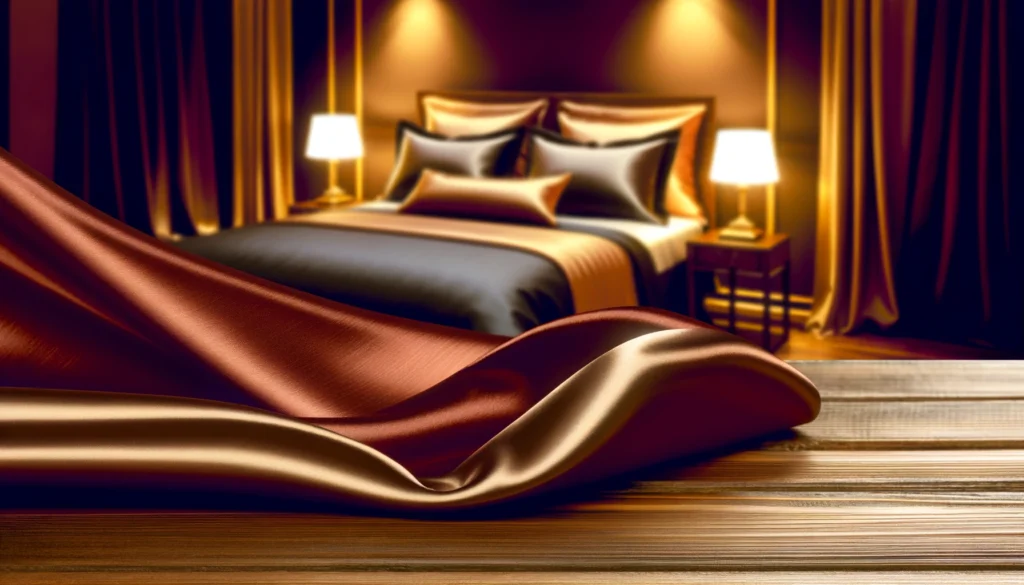
Satin Bedding: Smooth, Shiny, and Simply Divine
Luxurious satin bedding is your best choice to add elegance and sophistication to your bedroom. Crafted from silky smooth fibers, satin sheets bedding will charm you with its softness, lustrous appearance, and opulent feel.
A plain bright surface lies at the heart of satin bedding’s appeal. The fabric’s distinctive lustrous finish reflects light beautifully, adding a touch of glamor to the bedroom and enhancing its prevalent aesthetic appeal.
One more defining feature of satin bedding is its soft and silky texture, achieved through meticulous weaving.
Satin adds a sense of splendor and classiness to the bedroom, elevating it to a realm of timeless elegance. Whether draped over the bed or layered with harmonizing accessories, satin sheets bedding instantly transforms the space, infusing it with a sense of luxury and sophistication.
Sateen Bedding Sets
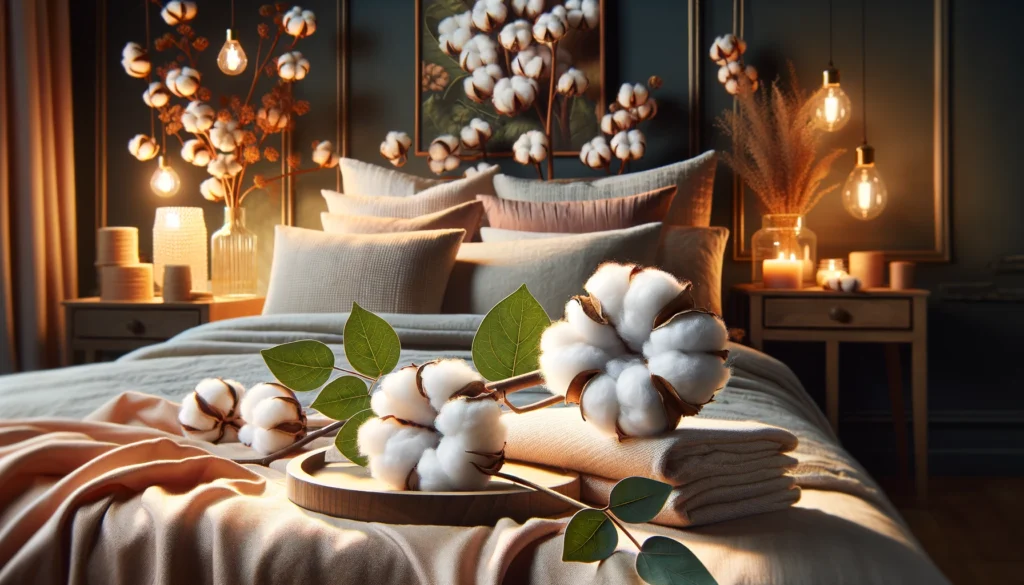
Sateen Bedding Sets: Silky Smoothness for a Luxurious Slumber
Sateen bedding sets are distinguished by their smooth, silky feel and excellent quality. Crafted from cotton, sateen bedding is a favored choice for those who want to combine sophistication with practicality.
A unique sateen weaving technique creates a lustrous surface with a subtle sheen. This pleasant texture promotes a perfect feel of relaxation, enabling deep and restful sleep.
Durability is another hallmark of sateen bedding sets, as the tight weave of the fabric enhances its strength and resilience. Despite its delicate impression, sateen bedding is designed to withstand regular use and laundering, ensuring its integrity and eye appeal over time.
Wrinkle resistance is another notable feature of sateen bedding, as the fibers minimize creasing, even after washing. This ensures that the bedding always looks fresh and pristine.
Sateen bedding is porous enough, allowing air to circulate freely and wick away moisture, but it is not as breathable as, say, linen or wool. Also, keep in mind that sateen fabric can pill over time.
Far and by, sateen bedding delivers a luxurious sleeping experience characterized by its smooth, silky feel, durability, and elegant look.
Choosing the Right Fabric for Your Needs

Choosing the Right Fabric for Your Needs: A Personalized Approach
Choosing the fabric for your bedding is crucial for creating a comfortable and conducive sleeping environment tailored to your preferences and needs. Consider the following factors when selecting the material:
- Climate:
- For warmer climates or hot sleepers, breathable fabrics like cotton, linen, or Tencel would be ideal.
- In colder climates, opt for fabrics with high insulating properties, such as flannel or wool.
- Allergies:
- Choose hypoallergenic materials such as bamboo, Tencel, or organic cotton. These fabrics are less likely to trigger allergic reactions and are gentle on sensitive skin.
- Avoid fabrics treated with harsh chemicals or dyes (polyester, nylon, rayon, acrylic, polyester-cotton, or similar synthetic blends.
- Budget:
- Cotton and polyester blends are often more affordable, while silk or satin may be more expensive.
- Investing in high-quality fabrics may offer better durability and comfort in the long run, offsetting the initial cost.
- Fabric Quality:
- Consider factors such as thread count, weave, and fiber type.
- Better quality is not necessarily related to a larger thread count. Instead, focus on the fabric’s feel and durability. Look for smooth, tightly woven fabrics with a soft hand feel.
- Choose natural fibers like cotton, linen, or bamboo for excellent breathability, moisture-wicking properties, and convenience.
- Understanding Labels:
- Read product labels carefully to understand the fabric content and care instructions.
- Look for certifications such as OEKO-TEX Standard 100 or GOTS (Global Organic Textile Standard), guaranteeing organic and eco-friendly production practices.
- Familiarize yourself with standard fabric terms and their implications. For example, “Egyptian cotton” refers to a premium-quality cotton known for its long fibers and luxurious feel.
Maintenance and Care Tips for Fabrics for Bedding

Proper maintenance and care are paramount for extending life and preserving the quality of bedding made from different fabrics. Here are some tailored care tips for typical bedding fabrics:
- Cotton:
- Wash in warm water with a mild detergent to prevent shrinking and fading.
- Choose a gentle wash cycle to preserve the integrity of the material.
- Do not overfill the washer to assure thorough cleaning.
- Tumble dry on low heat or line dry to prevent excessive shrinkage and wrinkling.
- Iron on a medium setting.
- Linen:
- Wash in cold water with a mild detergent to prevent shrinking and maintain color vibrance.
- Line drying is recommended to preserve the fabric’s texture and prevent excessive wrinkling.
- If using a dryer, tumble dry on low heat and remove promptly to minimize wrinkles.
- Iron while slightly damp on a high setting for a crisp finish, or embrace the natural texture of linen for a relaxed look.
- Silk:
- Hand wash in cold water with a gentle detergent or use a delicate cycle on the washer.
- Avoid wringing or twisting, as it can damage the fibers.
- Hang silk bedding to air dry away from direct sunlight to prevent fading and maintain its luster.
- Iron on the lowest setting while the fabric is still slightly damp, or use a steamer to remove wrinkles gently.
- Polyester:
- Machine wash in warm water with a mild detergent.
- Use a gentle cycle and avoid harsh agitation to prevent pilling and damage to the fabric.
- Tumble dry on low heat or air dry to minimize static and maintain the fabric’s shape and texture.
- Polyester bedding is usually wrinkle-resistant, but if needed, iron it on a low setting.
- Bamboo/Tencel:
- Do laundry with a gentle washing powder.
- Use a gentle cycle to prevent excessive wear and preserve the fabric’s softness.
- Line dry or tumble dry on low heat to prevent shrinkage and maintain the fabric’s moisture-wicking properties.
- Iron on a low setting if necessary.
Regardless of the fabric type, always check the care label for specific instructions. Proper care and maintenance are essential for preserving the quality and longevity of bedding, ensuring a comfortable sleep environment for years to come.
Conclusion

Conclusion: Elevate Your Sleep Experience with the Perfect Bedding Fabric
The universe of fabric choices for bed linen is vast and diverse. With numerous options available, it’s easy to feel overwhelmed and uncertain about making the right decision. However, I hope this article has provided you with comprehensive information about various bedding types to facilitate your selection process.
If you have room in your budget and strive to infuse your bedroom with luxury, consider indulging in silk, satin, or velvet bedding. These rich materials exude elegance and sophistication, elevating the ambiance of any sleeping space.
If you prioritize eco-friendliness, sustainability, or hypoallergenic properties, explore options such as linen, bamboo, wool, or Tencel bedding. These natural and environmentally conscious materials not only offer comfort but also provide peace of mind, knowing you’re making a green choice for your sleep environment.
For those with modern bedrooms boasting a minimalist aesthetic, bedding sets crafted from cotton, satin, or microfiber are ideal. These fabrics effortlessly complement contemporary décor while providing the comfort and style you crave.
Investing in high-quality bedding tailored to your personal preferences is paramount. By doing so, you can curate a uniquely personal space in your bedroom where you can unwind, sleep soundly, and awaken refreshed.
Embrace the luxury of exquisite bedding fabrics and transform your sleeping space into an oasis of comfort and bliss. With the right choice of bedding, every night becomes an indulgent retreat, enhancing your overall well-being and enjoyment of your home.
